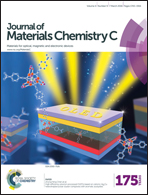Spontaneous generation of interlayers in OPVs with silver cathodes: enhancing Voc and lifetime†
Abstract
A major contribution to the performance improvement of organic photovoltaic (OPV) devices is due to the successful engineering of the metal/organic interface by introducing interlayers. We suggest a new methodology for processing interlayers by the spontaneous segregation of additives to a silver cathode. The driving force for this special migration is the chemical interaction between the thiol end groups of the additive and the thermally deposited Ag metal atoms. In addition to the end groups, the additive is also selected to modify the Ag work function and effectively increase the device Voc. Here we show that a spontaneously generated hexa(ethyleneglycol)-dithiol (HEG-DT) interlayer at the P3HT:PCBM/Ag interface increases the Voc by over 0.1 V and enhances the device efficiency by more than 76%, to ∼3% PCE. The presence of the interlayer is confirmed by measuring the composition of the blend/Ag interface using XPS. Furthermore, the spontaneously generated interlayer also suppresses the oxidation of the organic/Ag interface and stalls the interfacial degradation. Consequently, due to the presence of the interlayer the life-time of non-encapsulated devices stored and operated under ambient conditions is increased by a factor of 7.


 Please wait while we load your content...
Please wait while we load your content...